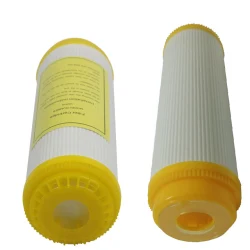Here are key aspects of ion exchange resin filters
2023-12-28
Ion exchange resin filters are a type of water treatment technology that uses ion exchange resins to remove specific ions from water. These filters are commonly employed in water softening systems to reduce the hardness of water by exchanging calcium and magnesium ions with sodium ions. Here are key aspects of ion exchange resin filters:
1. Ion Exchange Resin:
- Material: Ion exchange resins are typically made from porous polymer beads with functional groups that can attract and exchange ions.
- Functional Groups: Common functional groups include sulfonate (for cation exchange) and quaternary ammonium (for anion exchange).
2. Ion Exchange Process:
- Cation Exchange: In water softening applications, cation exchange resins attract and exchange calcium and magnesium ions (hardness ions) with sodium ions. The resin releases sodium ions into the water.
- Anion Exchange: In some applications, anion exchange resins can be used to remove anions such as nitrate or sulfate.
3. Water Softening:
- Purpose: The primary application of ion exchange resin filters is water softening to reduce the hardness of water.
- Hardness Removal: Calcium and magnesium ions, which contribute to water hardness, are exchanged for sodium ions in the resin, resulting in softened water.
4. Regeneration:
- Exhaustion: Over time, ion exchange resins become exhausted as they reach their capacity to exchange ions.
- Regeneration: The resin can be regenerated by flushing it with a concentrated solution of sodium chloride (brine), which replaces the adsorbed calcium and magnesium ions with sodium ions.
5. Types of Ion Exchange Resin Filters:
- Cation Exchange Resins: Used for water softening by removing calcium and magnesium ions.
- Anion Exchange Resins: Used to remove anions such as nitrate or sulfate, although this is less common in residential water softening.
6. Mixed-Bed Ion Exchange Resins:
- Composition: These resins contain a mixture of cation and anion exchange resins.
- Applications: Mixed-bed resins are used in applications where high-purity water is required, such as in laboratory settings or certain industrial processes.
7. Water Quality Improvement:
- Scale Prevention: Ion exchange resin filters prevent the formation of scale deposits caused by calcium and magnesium ions in water, which can accumulate in pipes and appliances.
- Soap Efficiency: Softened water improves the efficiency of soaps and detergents by reducing the interference of hardness ions.
8. System Components:
- Tank: The ion exchange resin is typically housed in a tank or vessel where the exchange process occurs.
- Control Valve: Automated water softeners have control valves that initiate regeneration cycles based on water usage and hardness levels.
9. Maintenance:
- Regular Regeneration: Periodic regeneration is necessary to maintain the efficacy of the ion exchange resin.
- Salt Refilling: In systems that use brine for regeneration, adding salt is required to replenish the sodium ions in the resin.
10. Applications:
- Residential Water Softeners: Commonly used in households to improve water quality and extend the lifespan of plumbing and appliances.
- Industrial and Commercial Water Treatment: Applied in various industries to address water hardness and specific ion removal requirements.
Ion exchange resin filters are effective for addressing water hardness issues and improving the quality of water for various applications. They are widely used in both residential and industrial settings, providing a reliable method for achieving water softening and ion removal.



